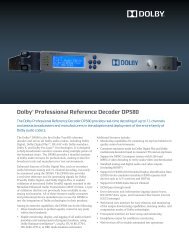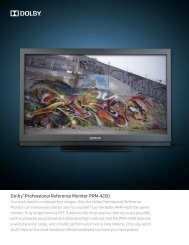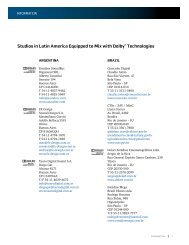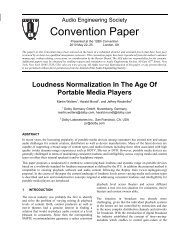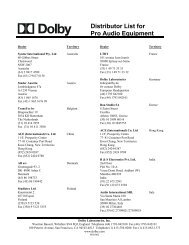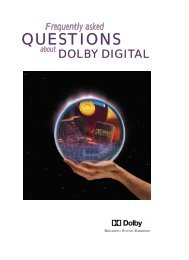Screen Sizes Impact on Picture and Sound - Dolby Laboratories Inc.
Screen Sizes Impact on Picture and Sound - Dolby Laboratories Inc.
Screen Sizes Impact on Picture and Sound - Dolby Laboratories Inc.
Create successful ePaper yourself
Turn your PDF publications into a flip-book with our unique Google optimized e-Paper software.
Very<br />
Involving<br />
Not<br />
Involving<br />
<strong>Picture</strong> Involvement<br />
Quality Improvements<br />
30º<br />
5<br />
45º<br />
<str<strong>on</strong>g>Screen</str<strong>on</strong>g> Size<br />
INVOLVEMENT<br />
QUALITY<br />
Figure 4: Optimum “screen size”–1953 Cinemascope<br />
There is no doubt that some issues relating to film performance have improved<br />
since 1953. Release print stock, in particular, now has much finer grain than 40<br />
years ago. On the other h<strong>and</strong>, jump <strong>and</strong> weave in many modern projectors are<br />
probably no better than they used to be—<strong>and</strong> the lack of permanent<br />
projecti<strong>on</strong>ists assigned to each screen means that focus is less accurately<br />
maintained than used to be the case. It probably would be optimistic to think<br />
that the optimum screen angle for Cinemascope has progressed much above 45<br />
degrees. Perhaps the same evaluati<strong>on</strong> carried out today would lead to a number<br />
no greater than 50 degrees.<br />
1.85 v Scope<br />
The 1.85:1 aspect ratio is extremely inefficient, in that approximately 35 percent<br />
of the film frame area is thrown away (Figure 5). Eighty percent of US movies<br />
are shot with this aspect ratio. (This ratio was not chosen for image quality, but<br />
for image shape—a cheaper alternative than Cinemascope, providing a<br />
“wide-angle” image, but using spherical, n<strong>on</strong>-anamorphic lenses.)<br />
60º



